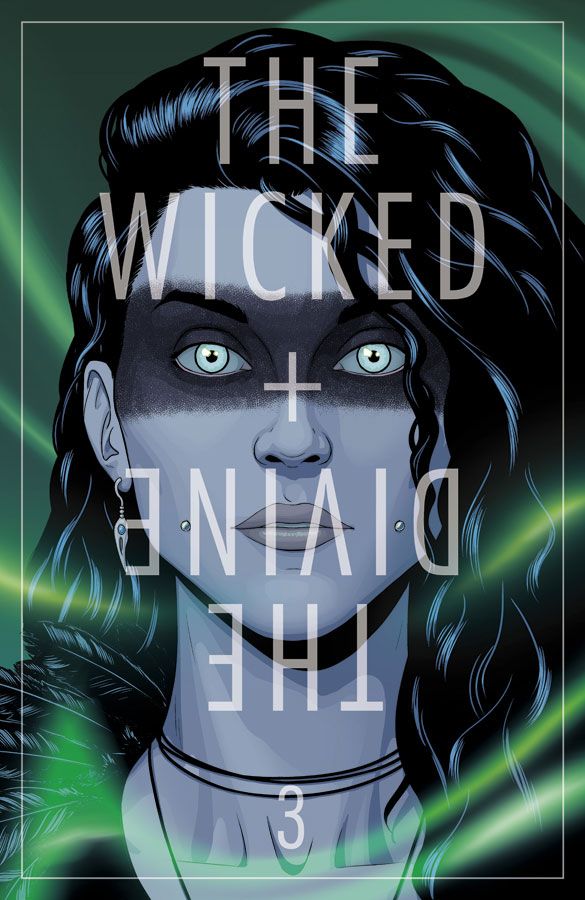Even when a god's severed head gets involved, Laura realizes that the show must go on and continues her hunt for the person who framed Luci in Kieron Gillen and Jamie McKelvie's "The Wicked and the Divine" #3. Gillen and McKelvie follow up last week's dramatic cliffhanger with an equally dramatic clash between two angry pop gods, featuring a display of raw power that will leave both Laura and the reader reeling. With two striking new additions to their pantheon, dynamic artwork and durable humor, Gillen and McKelvie will make true believers of us all.
Without missing a beat, Gillen and McKelvie produce an issue just as packed with action and revelations as the previous two, but it's their bewitching new characters that steal the show. Both Baphomet and the triple-headed Morrigan easily ingratiate themselves with the reader by going at each other immediately; Baphomet's rough edges and dangerous attitude just dance alongside the Morrigan's ferocity, quick shifts and many faces. Their exchanges feel just as lyrical as they are deadly, establishing their relationship in just a few panels and contributing wonderfully to their chemistry.
Both Baphomet and the Morrigan's designs skew more towards the bizarre than any other members of the pantheon so far, going so far as to include fanged teeth and big silver eyes, but this small shift towards the ethereal simply pads Gillen and McKelvie's flawless world building. Further, this and their power display strengthens the supernatural dimension of the story. McKelvie's way of working in their mythological symbols -- like Baphomet's goathead pendant and the Morrigan's crow-inspired clothing and sleeve tattoo -- links the characters back to their origins with visually stunning ingenuity. The Morrigan's triple-faced nature is particularly well executed with a clever visual device that ties into her originating myth.
Matthew Wilson's work on this issue stands out tremendously for the atmosphere of the Underworld; although the overall tone is dark, he adds color that shapes the mood, utilizing vivid red hughes for Baphomet's hot temper and electric green for the Morrigan's cooler but equally intense rage. His colors even out as Laura leaves this setting, which ultimately contributes to the unearthly aura that the Morrigan and Baphomet inspire. As usual, Wilson is absolutely on point here. The same is easily said for Clayton Cowles, whose creative lettering adds to the brilliance of the whole series, including one particularly chilling speech bubble that bursts open in an explosion of green lightning.
Although the Morrigan and Baphomet's musical battle makes for some high-octane entertainment, Gillen and McKelvie's most effective sequence comes at the end of the issue in a coffee-shop recess with Laura and Cassandra. Gillen and McKelvie gracefully sidestep Laura's role as the middleman by syncing up Cassandra's questions with Luci's answers, which acknowledges Laura's efforts as a go-between without the drudgery of trudging back and forth. What's more, this serves as an indirect introduction to some of the players who have yet to walk on stage, preparing readers for new characters in a hilarious and upbeat way. However, this scene would be nowhere near as compelling without McKelvie's dynamicism and range. He switches between the two characters only for almost three whole pages, but he never once comes across as repetitious, using jaw-dropping versatility in expression and body language. The characters' synced motions provide some chuckle-worthy humor and nice parallelism, while their dead-eyed stare at the reader adds an almost personal touch. McKelvie takes a scene that could so easily become boring and renders it remarkable with his precision and attention to detail. His skill here, while subtle, is simply exquisite.
As fun and fantastic as this issue reads, it's not without a few hiccups. The pacing seems a little off with a fast opening, an abrupt halt midway through, and a more gradual drift before pulling up short in a cliffhanger. That is, as the issue gears towards a big showdown, the story cuts away and gives no explanation as to what happened or what the stakes were. While this book feels much more like a character piece than a plot-driven juggernaut so far, this disparity is rather disappointingly noticeable. Additionally, no context or attention is given to where the Morrigan's severed head came from or how that series of events worked. In all, there are just a few wrinkles that Gillen and McKelvie need to smooth out as they continue this epic.
Gillen and McKelvie keep on strong in their third issue of this innovative, captivating series. It's delicious. It's decadent. Simply put, reading "The Wicked and the Divine" is a religious experience in and of itself.

